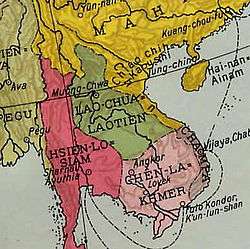Fourth Chinese domination of Vietnam
| Giao Chỉ Jiaozhi | |||||
| Province of the Ming dynasty | |||||
| |||||
 | |||||
| Government | Ming hierarchy | ||||
| History | |||||
| • | Defeat of the Hồ dynasty | 1407 | |||
| • | Defeat of the Later Trần dynasty | 1413 | |||
| • | End of the Lam Sơn uprising | 1427 | |||
| ||||||||||||||||||||||||||||||||||||||||||||||||||||
|---|---|---|---|---|---|---|---|---|---|---|---|---|---|---|---|---|---|---|---|---|---|---|---|---|---|---|---|---|---|---|---|---|---|---|---|---|---|---|---|---|---|---|---|---|---|---|---|---|---|---|---|---|
|
||||||||||||||||||||||||||||||||||||||||||||||||||||
|
Further subjects
|
||||||||||||||||||||||||||||||||||||||||||||||||||||
The fourth Chinese domination was a period of the history of Vietnam, from 1407 to 1427 during which the country was ruled by Ming dynasty administrators. It was the result of the conquest of the region by invading Ming armies in 1406 to 1407. The other three periods of Chinese domination, collectively known as the Bắc thuộc periods in Vietnam, were longer lasting, constituting much of Vietnam's history from 111 BC to 939 AD.
History
Revolt of Later Trần
With the Ming dynasty growing weak with internal rebellions and mismanagement during late Ming dynasty, control of Giao Chỉ (Jiaozhi), as the Chinese called northern Vietnam at this period, also weakened. There was several revolts among the Vietnamese people against the Ming authorities, only to be crushed by the Ming army. Among the people who led the rebellion were, Trần Ngỗi (revolted 1407-09), a young son of the late emperor Trần Nghệ Tông and Trần Quý Khoáng, a nephew. These revolts were short-lived and poorly planned but they helped lay some of the groundwork for Lê Lợi's war for independence.
Lam Sơn uprising
Lê Lợi, one of Vietnam's most celebrated heroes, is credited with rescuing the country from Ming domination in 1428. Born of a wealthy landowning family, he served as a senior scholar-official until the advent of the Ming, whom he refused to serve. After a decade of gathering a resistance movement around him, Le Loi and his forces finally defeated the Ming army in 1428. Rather than putting to death the captured Ming soldiers and administrators, he magnanimously provided ships and supplies to send them back to China. Le Loi then ascended the Vietnamese throne, taking the reign name Lê Thái Tổ and establishing the Lê dynasty (1428-1788).
Culture
The Ming invasion had been preceded by a campaign against Chinese culture during the combined 7-year reigns of the two emperors of the Hồ dynasty, Hồ Quý Ly in 1400 and his second son, Hồ Hán Thương, from 1400 to 1407. During these 7 years the two Hồ emperors asserted Vietnamese culture and language and banned use of Chinese language and writing in government. When the Ming invaded the cultural campaign was reversed; all classical Vietnamese printing blocks, books and materials relating to Vietnam were suppressed. For this reason almost no vernacular chữ nôm texts survive from before the Ming invasion. Various ancient sites such as pagoda Bao Minh were looted and destroyed. The Ming dynasty wanted to spread more of its Chinese culture in the area.
Economy
The Chinese had greatly encouraged the development and the use of gold and silver mines. But right after the silver and gold were extracted they impounded them and sent a fraction of these minerals to Beijing. They also imposed salt taxes, but a slightly heavier tax against those who produced salt in Annam.
Military and administration
To keep the people under control in Vietnam, the Ming government issued, and utilized the "So Ho" system, (literally meaning Family Book) at the lowest village community level. Whenever there was a change in a family, a change in the book was recorded and approved. Based on this information, they created a systematic military service enrollment process for all young men deemed fit enough to serve in the future for the Imperial Chinese Army. This process was no different than what other governments did to subjugated areas, nonetheless, this had created a negative feeling against the Chinese government. In addition, many talented Vietnamese individuals with varying trades and backgrounds who could make significant contributions were allowed to become government officials in China where they served in the Chinese imperial government.
See also
References
Further reading
- Viet Nam Su Luoc by Trần Trọng Kim
- Viet Su Toan Thu of Pham Van Son
- Tsai, Shih-shan Henry. (1996). The Eunuchs in the Ming Dynasty (illustrated ed.). SUNY Press. ISBN\ 1438422369. Retrieved 7 August 2013.
| Preceded by Hồ dynasty Later Trần dynasty |
Fourth Chinese domination of Vietnam 1407–1427 |
Succeeded by Later Lê dynasty |
